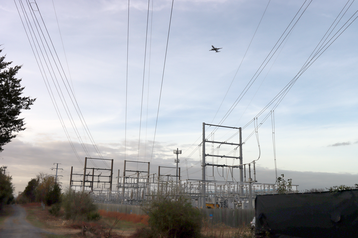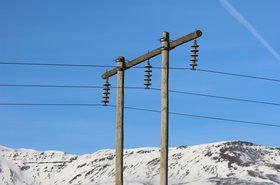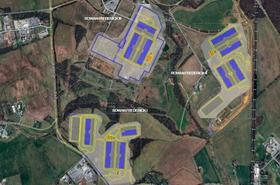The notion of power scarcity is being laid bare in countries across the world.
With defacto moratoriums on new data centers in Irish capital Dublin, restrictions in Amsterdam and Singapore (though in the city-state those are starting to ease), and reports that data centers are delaying residential developments in London due to power shortages, the message is clear: data centers are using up too much power, and the grid can’t handle it.
When it comes to the United States of America, the picture is less clear.
“In America, we say ‘all politics is local’,” says IDC analyst Sean Graham. “In the US, all power is also local. I don’t think I could say there’s an overall scarcity problem in the US, but there are definitely areas where getting a connection to the power grid is a problem.”
Despite the difficulty in trying to analyze such an enormous market, regular studies of the US grid are conducted and most find that, in keeping with other parts of the world, demand is rocketing.
Alongside this growing demand, the Department of Energy (DOE) is indeed looking at some “nationwide” solutions. For example, earlier this year, the DOE proposed setting up ten transmission corridors across the county that would allow for the rapid expansion of the power grid. These corridors are being described as “national interest electric transmission corridors,” (NIETCs) and cover more than 3,500 miles of the US.
Analysis by Grid Strategies, using data from the 2023 Federal Energy Regulatory Commission (FERC) filings of grid planning entities, found that in 2022 the forecast for 2028’s peak demand was 835GW. By 2023, this forecast had risen to 852GW. The study also noted that this is likely an underestimate: “Several more recent updates are adding additional GWs to that forecast,” it warned. “Next year’s forecast is likely to show an even higher nationwide growth rate.”
Among the main drivers for this expected growth in power demand are data centers.
Is the power supply there?
IDC’s Graham maintains that it is not practical to view US power problems on a national scale, because demand will be condensed in some areas more than others. Among the key locations with grid constraints noted by the analyst are, predictably, Northern Virginia - aka data center alley - and California.
Northern Virginia has the largest concentration of data centers in the world. It is the hub of the industry and, in 2022, utility company Dominion Energy admitted that it may not be able to meet the demands for energy in the areas particularly densely populated with data centers as its high voltage lines simply could not handle more power.
The US power grid is comprised of nine regional and acronym-heavy operators, which are responsible for the infrastructure used by power companies: NYISO, ISO-NE, PJM, MISO, SPP, ERCOT, CAISO, and West (non-ISO) and Southeast (non-ISO).
According to the Lawrence Berkeley National Laboratory’s (LBNL) ‘Queued Up: 2024 Edition,’ there are currently nearly 12,000 projects with 1,570GW of generator capacity and 1,030GW of storage capacity ‘queued’ to get connected to the grid. More than 94 percent of this proposed generation capacity is zero carbon.
While this suggests that there are more than enough power projects to match growing demand, the LBNL noted that more than 70 percent of interconnection requests are withdrawn. In fact, only 19 percent of requests between 2000 and 2018 were built by 2023.
These high-level findings give us an idea of the longer-term grid strategy for the nation but do little to address the immediate issue of the data center industry’s growing demand, a problem that has only been exacerbated by the artificial intelligence (AI) boom.
The LBNL report itself notes this, and suggests that comparing the five-year expected peak load growth with the peak load of projects that have been granted interconnection agreements is a better measurement of the grid’s capacity to handle load growth that is being “driven by transport electrification, manufacturing growth, and data centers.”
In the CAISO (California) and ERCOT (Texas) regions, the projects with approval far outweigh the expected load growth, but it is a different story when we turn to MISO (Midcontinent Independent System Operator) and PJM, which is part of the Eastern Interconnection grid and serves Northern Virginia.
PJM has said that it expects to see grid loads in its transmission zones jump by almost 40 percent over the next 15 years. Having released its 2024 PJM Load Forecast Report in January, the grid provider noted: “Rising energy demand in the region PJM serves is increasingly driven by the development of data centers throughout the PJM footprint, combined with the accelerating electrification of transportation and industry.”
In Virginia, demand on Dominion’s portion of the grid is expected to grow from 22GW in 2024, to 42GW by 2039. In April 2024, Dominion Energy put out a request for proposals for solar, onshore wind, and energy storage development projects in Virginia.
In late 2023, PJM stated that it hoped to clear 300 new generation projects for interconnecting in 2024 with 26GW of generating capacity, though this would not only cover Dominion’s domain. PJM serves Delaware, Illinois, Indiana, Kentucky, Maryland, Michigan, New Jersey, North Carolina, Ohio, Pennsylvania, Tennessee, Virginia, West Virginia, and US capital Washington DC.
Should the interconnection requests go through and the supply be developed, things will be looking up. But this remains far from certain, making life difficult for data center developers.
IDC’s Graham says there are different strategies available to handle grid constraints. One of these is simply to stop building data centers in areas where power supply is a challenge.
“What we are seeing happen is that the AI data centers used for training are in very different locations than the Tier One metro markets for connecting users and data centers,” says Graham.
“For example, Meta is in Cheyenne, Wisconsin. And Amazon has its location in Northeast Pennsylvania attached to a local power plant.”
He notes that this can apply to other data centers too - if they are willing to compromise on that little bit of latency, and “rather than being five miles outside of a metro, extending to 20 miles for power to be available.”
Graham also points to another scheme being pursued across the Atlantic in Ireland as a potential solution for data center companies seeking elusive power supply. In June 2024, it was revealed that Amazon, Google, and Microsoft were pushing the Irish government to allow them to build their own private power lines to connect their data centers to renewable energy projects.
The idea behind this is to ease the ongoing pressure on power supply in the Dublin area, where there is currently a moratorium on new grid connections for data centers. At present, only the state-owned Electricity Supply Board is allowed to build power lines to connect properties to the grid. The government has yet to approve such a scheme but said it will publish a policy on private wires in the last quarter of 2024.
The final strategy posited by Graham is to eliminate any reliance on the national grid by setting up a dedicated power supply of your own. “A more evolving or emerging trend is using microgrids to bridge the gap, either to get the power sooner or as a backup source,” Graham says. “This gives organizations more options for how they will source their energy, and some places are even looking to data centers to sell energy back to the grid.”
Microgrids: A viable solution?
Jeff Gyzen is the group director of mission-critical and industrial at consultancy firm Arcadis and a big believer in microgrids.
He says power problems are impacting most Tier One data center markets. “In Northern Virginia’s Loudoun County, for example, Dominion, which provides all the grid power there, is telling developers that it's three to five years before they can deliver power, so the only option is to go with on-site microgrids,” Gyzen says.
Microgrids see data center developers take on the onus of generating power for their sites themselves. This can be done using renewable energy sources like solar or wind power, fuel cells, and, potentially, emerging technologies like small modular nuclear reactors. The power is then sent straight to the data center, bypassing any need to connect to the wider power network.
Gyzen notes that as and when more main grid capacity becomes available, data center operators could use their microgrids for backup power, or to provide energy back to the grid at times when supply doesn’t match demand.
In the context of Northern Virginia, this could make a lot of sense. “The first case I heard of where a developer had actually gone to onsite generation was Vantage Data Centers,” Gyzen adds. “At Vantage’s Ashburn campus, they installed natural gas-fueled turbines for onsite generation to bypass Dominion’s lack of power availability.”
Of course, along with having to provide their own power, data center operators with microgrids must also ensure sufficient redundancy, but Gyzen suggests this is not exactly a complex issue. “For instance, you could have two turbines powering what you need and then just have an additional one in there for the N+1 so you have redundancy built in,” he says.
However, data center operators wishing to go down the microgrid route often face regulatory hurdles. And, as with politics, this can be a local issue.
“California is probably the most difficult,” says Gyzen, after a pause. “The California Energy Commission (CEC) states that with 50MW or over, you have to get preliminary approval for your site. And at 100MW or more they consider you a utility and will regulate you. But that’s only for combustible energy sources.”
An example to get around this, Gyzen says, is a project Arcadis is currently working on: a 200-300MW campus in San Jose where they are using fuel cells. Fuel cells are not combustible, so the CEC won’t regulate them.
However, this depends on the type of fuel cell, as there is some debate as to whether it is actually the low-carbon technology it’s posited as.
While the solution, often gas-powered, remains cleaner than fossil fuels such as coal and oil - the Energy Information Administration estimates that coal produces about 1kg of CO2 per kWh, while electricity from oil produces about 1.1kg. In comparison, natural gas produces 430g of CO2 per kWh - it is still not up to par with the emissions from solar (48g/kWh), wind (12g/kWh), and nuclear (12g/kWh), per figures from the World Nuclear Association.
Regulations aside, the biggest barrier for those looking to set up microgrids remains the cost.
“It is a larger amount of upfront expense compared to tapping into the grid which has minimal immediate costs,” Gyzen concedes. “But a microgrid is for the long-term. Your initial investment will be significant, but that can be offset.” He offers an example of Bloom Energy, which does power purchase agreements for fuel cells, wherein they provide the cells and you buy the power from them at a reduced rate.
He adds: “If you want to purchase the power generation yourself, it can be extremely expensive. But you have to look long-term. In some markets like Northern California where the utility rates are 20 to 24 cents a kilowatt hour, you could end up saving a lot of money on a yearly basis.”
It is perhaps this upfront cost, and the nature of economies of scale, that leads Gyzen to suggest that it's only worth pursuing the microgrid solution for larger campuses. “You generally want to do onsite power generation in 100MW increments,” Gyzen says. “But, then again, if the power isn’t otherwise available then the only other option is to not build.”
However, for those smaller data center developments, IDC’s Graham notes that the microgrid could be viewed in a different light - as something of a stepping stone.
“The microgrid might be enough to get [a project] started,” says Graham. “If you are building a 10MW data center, you aren’t necessarily going to have 10MW on day one anyway. A microgrid could be a stop-gap until you get connectivity to the wider grid.”
Graham describes microgrids as an “emerging” and “evolving” trend, though agrees with Gyzen that they could be a major factor in taking the pressure off the US grid.
“I think microgrids are the way of the future for data centers,” argues Gyzen. “We shouldn’t be tapping into the utilities and draining them of all the power. We shouldn’t be creating these problems which then stagnate other developments too.”
Overall, despite the degree of uncertainty that surrounds power availability in some parts of the US, Graham remains optimistic.
“These companies are smart and they have the resources to figure it out,” he says. “Are microgrids enough to fill the gap? Maybe not. But you start combining all these strategies wherein you take the strain off of the grid. You move out from the concentrated hubs, combined with distributed energy sources, and maybe even improvements in networking technology, and suddenly there is a solution.”






